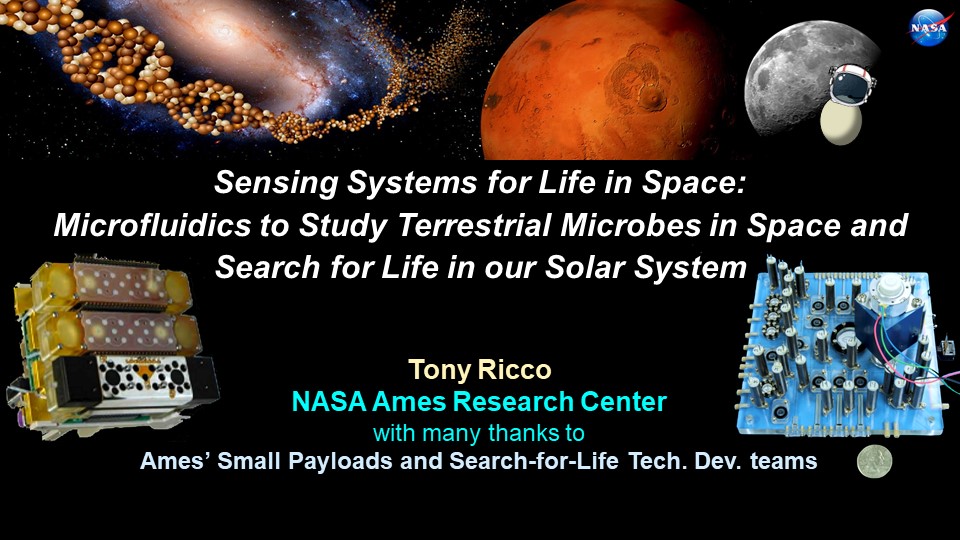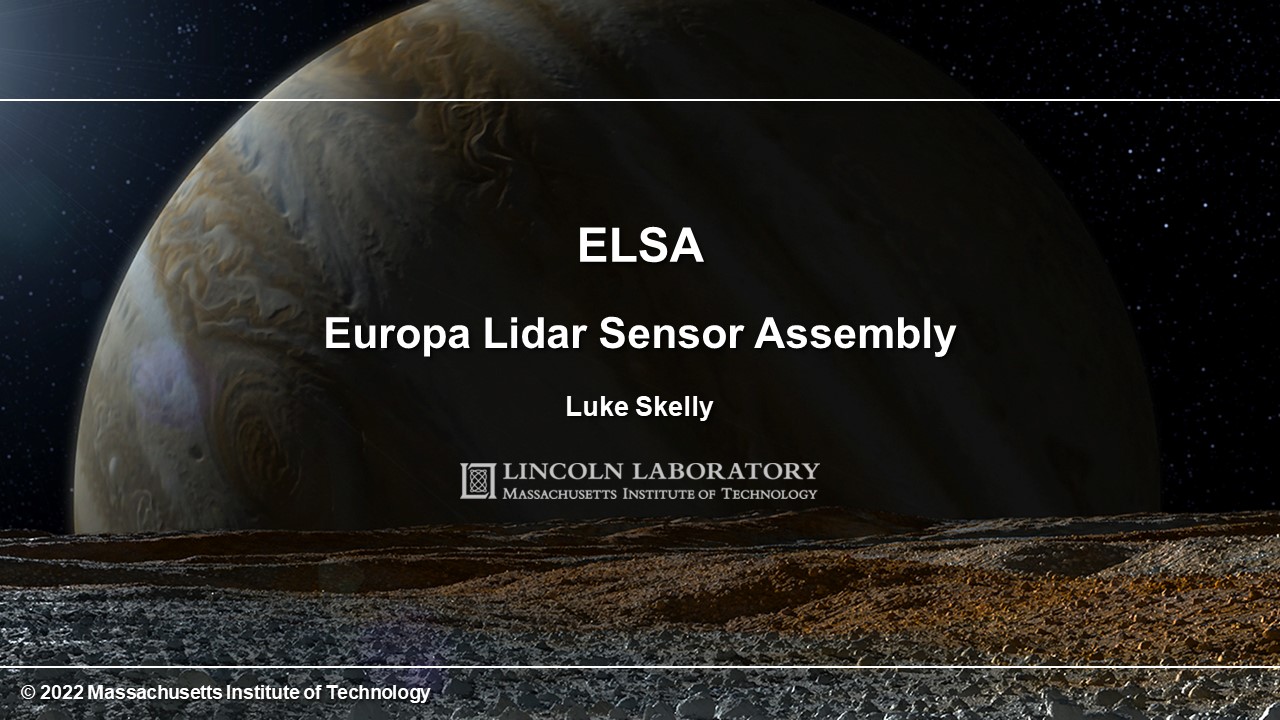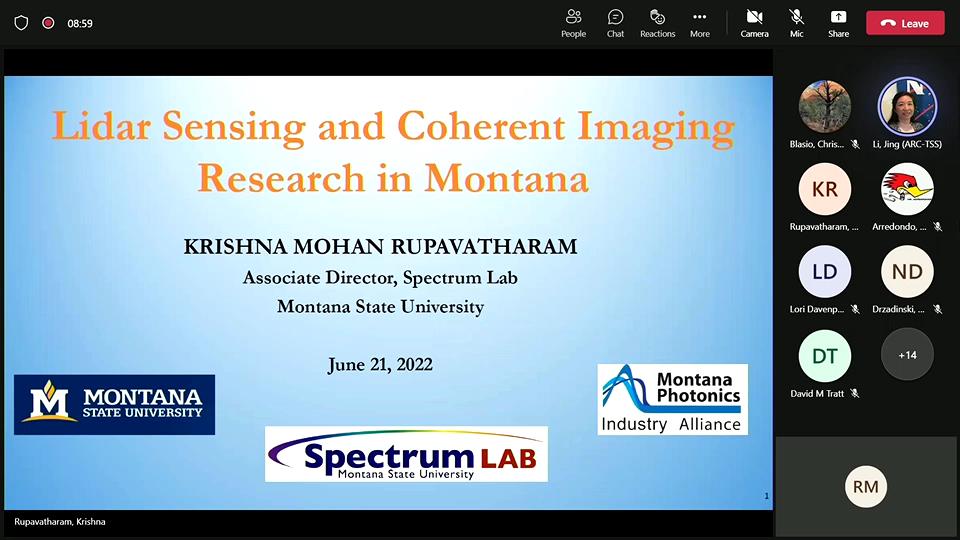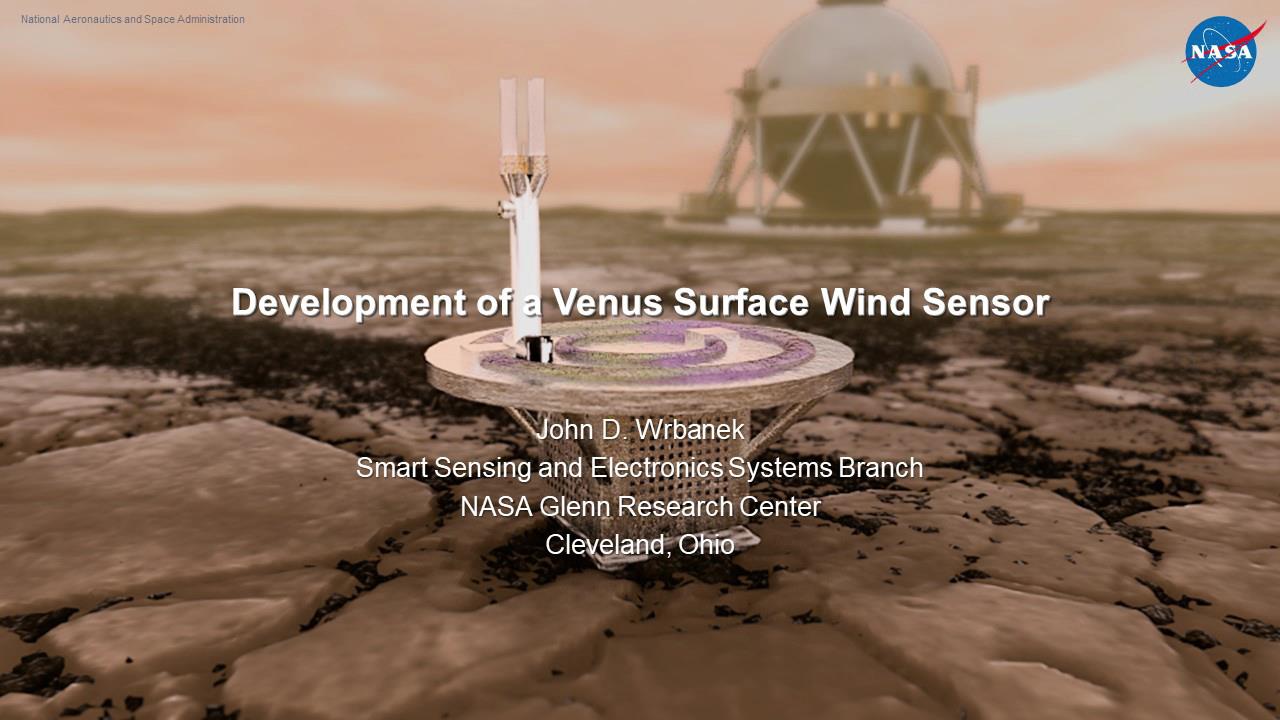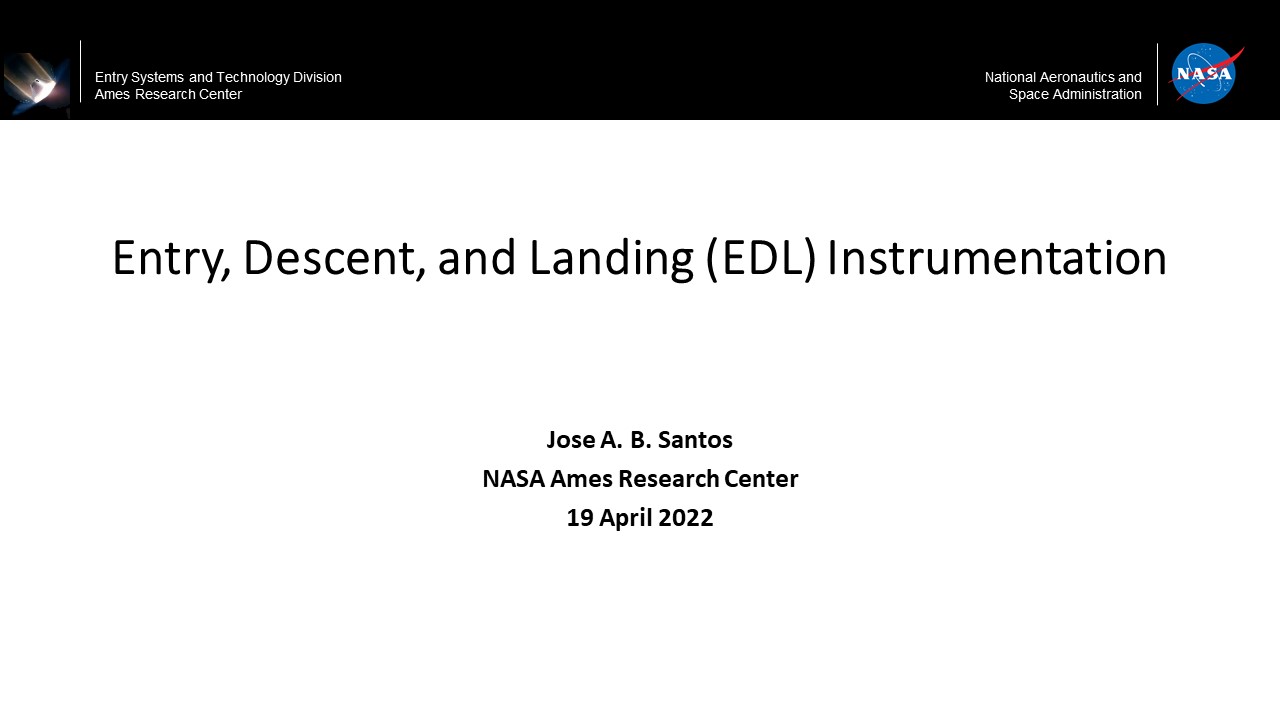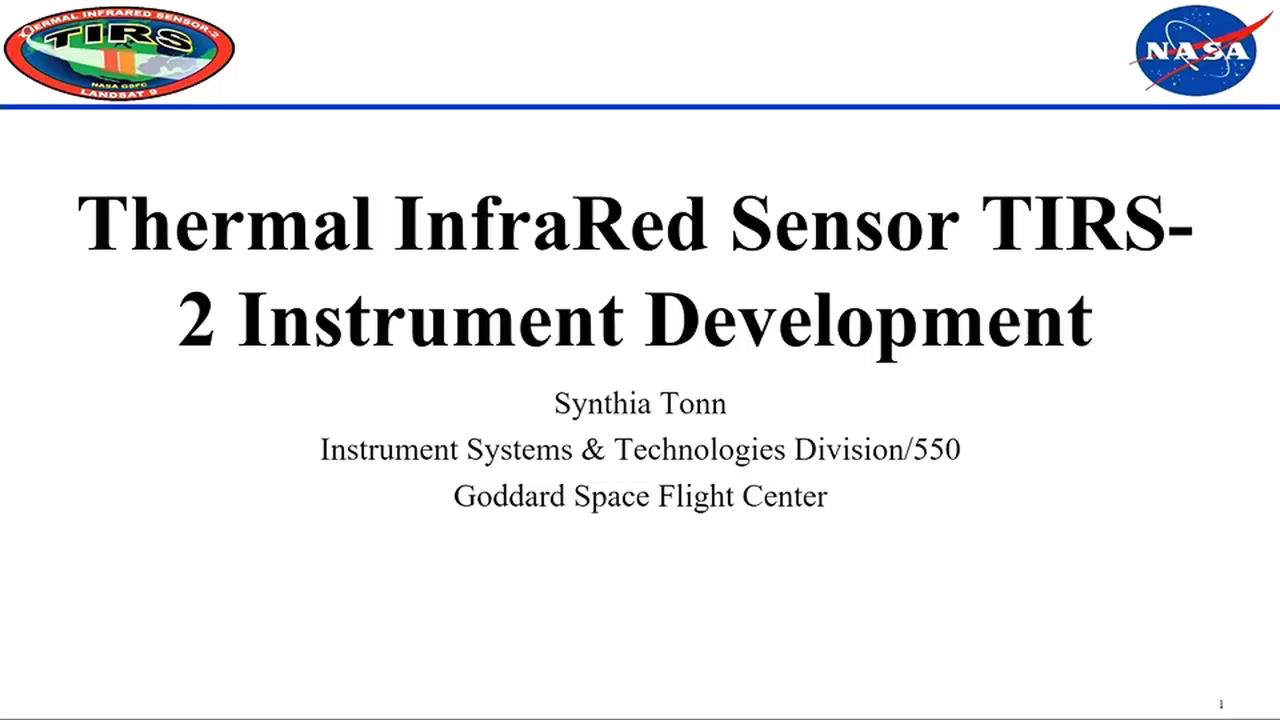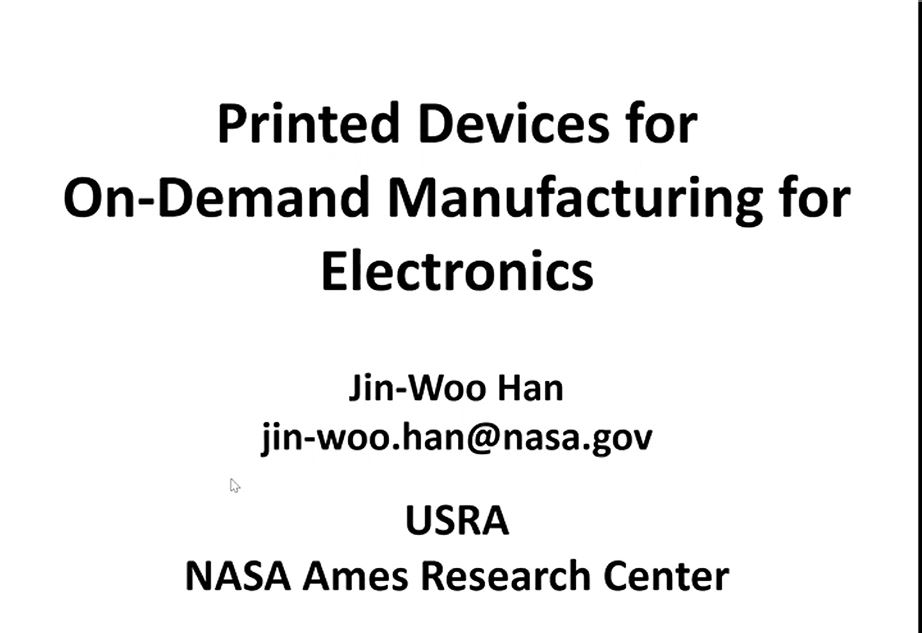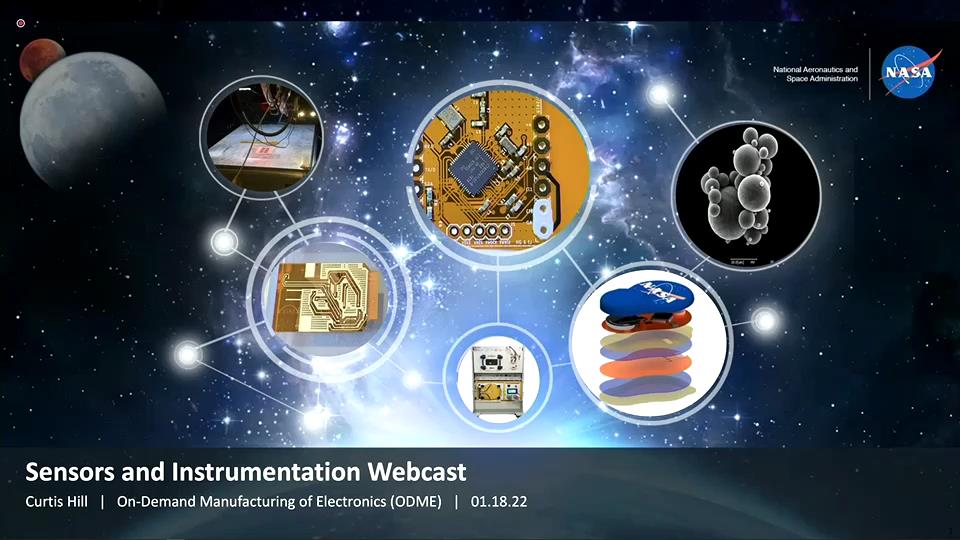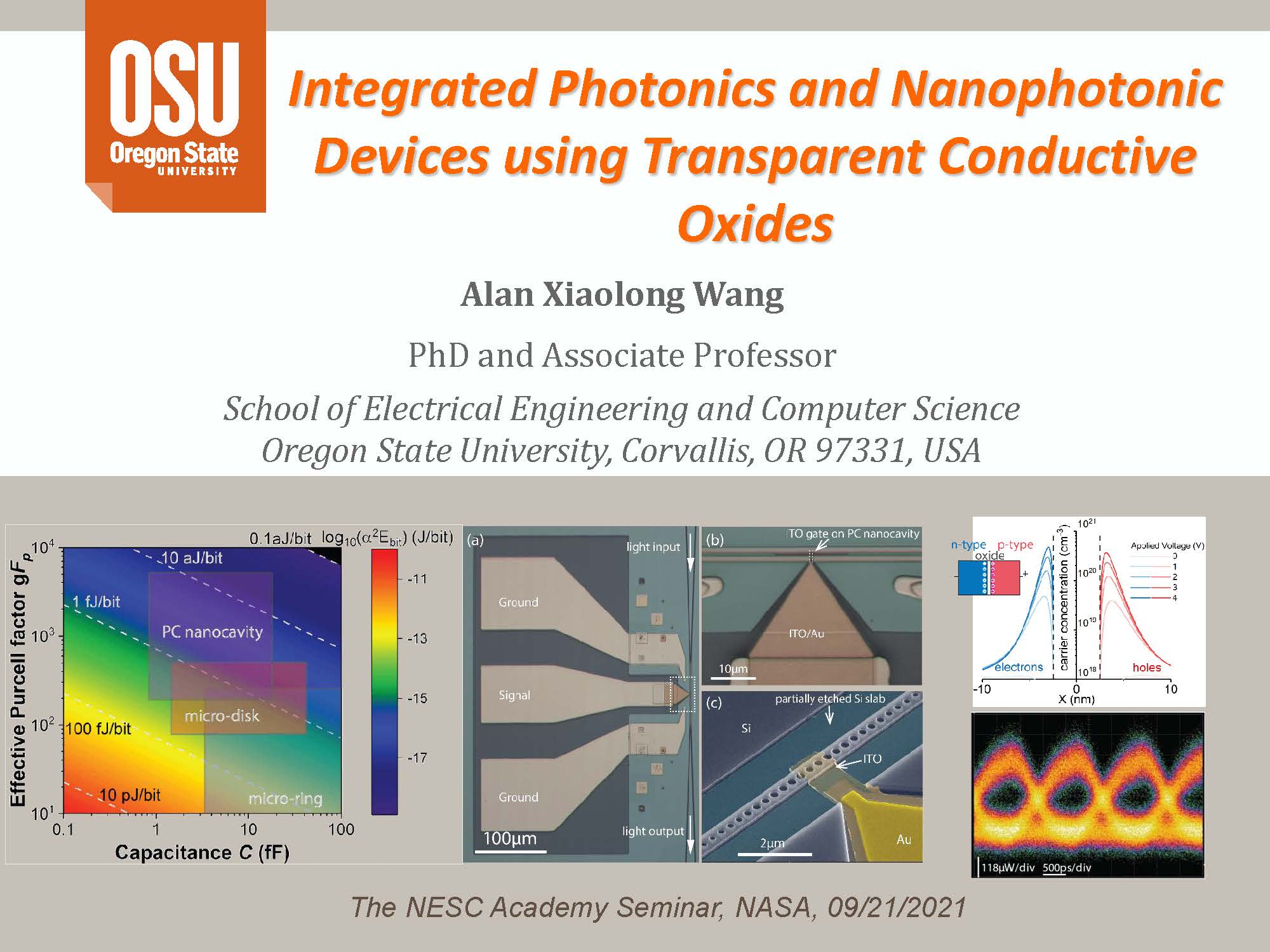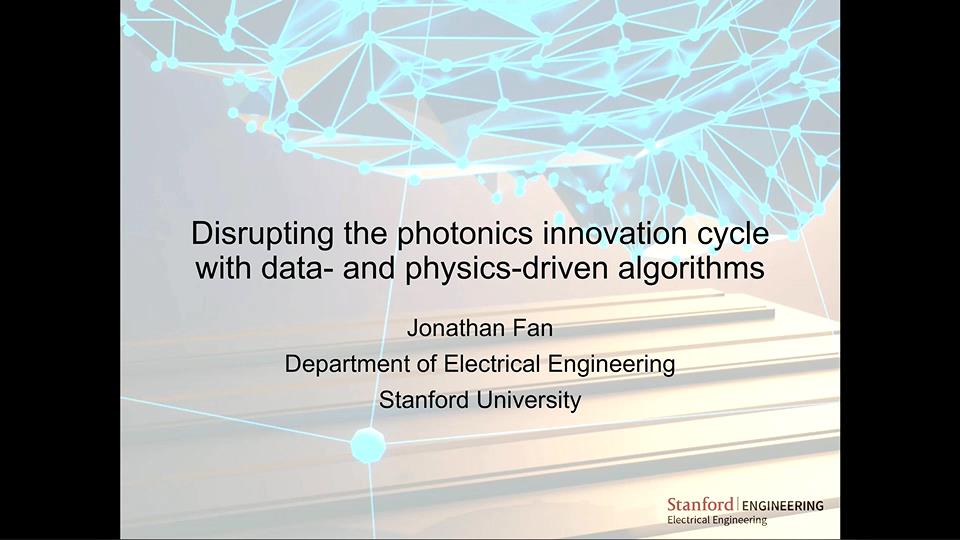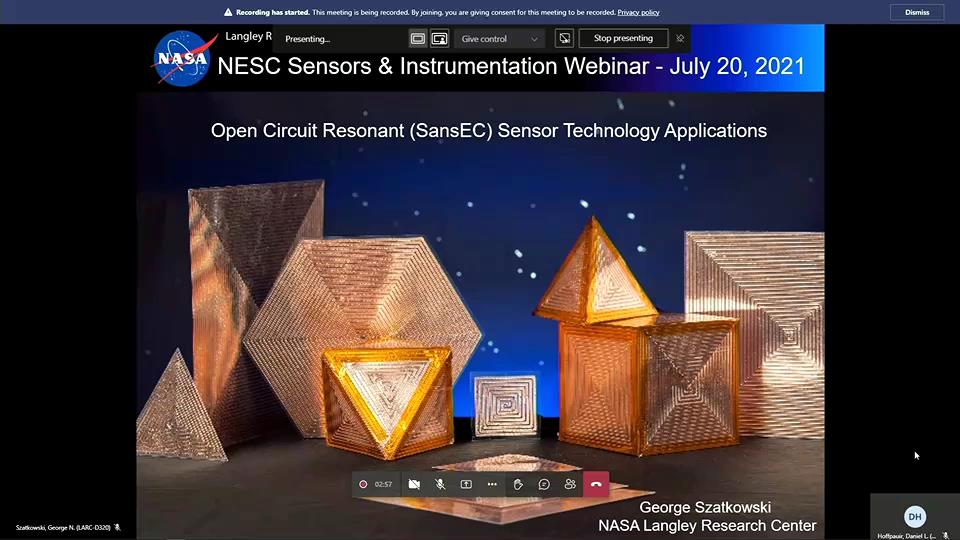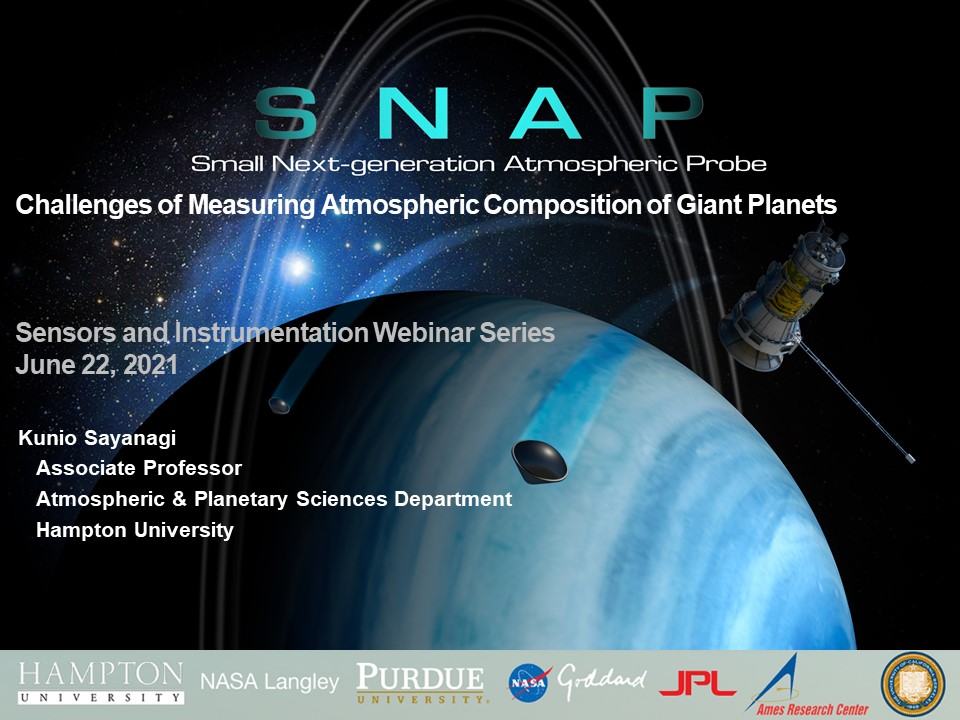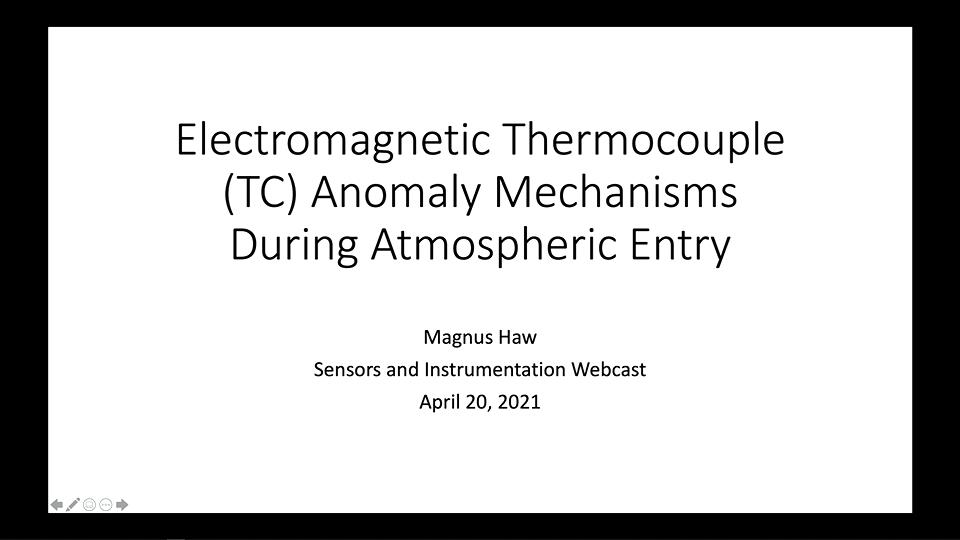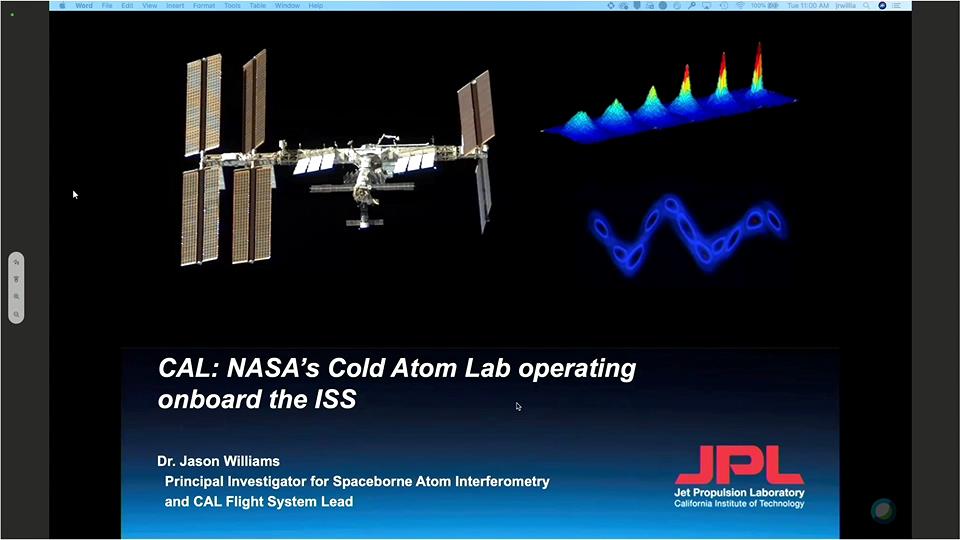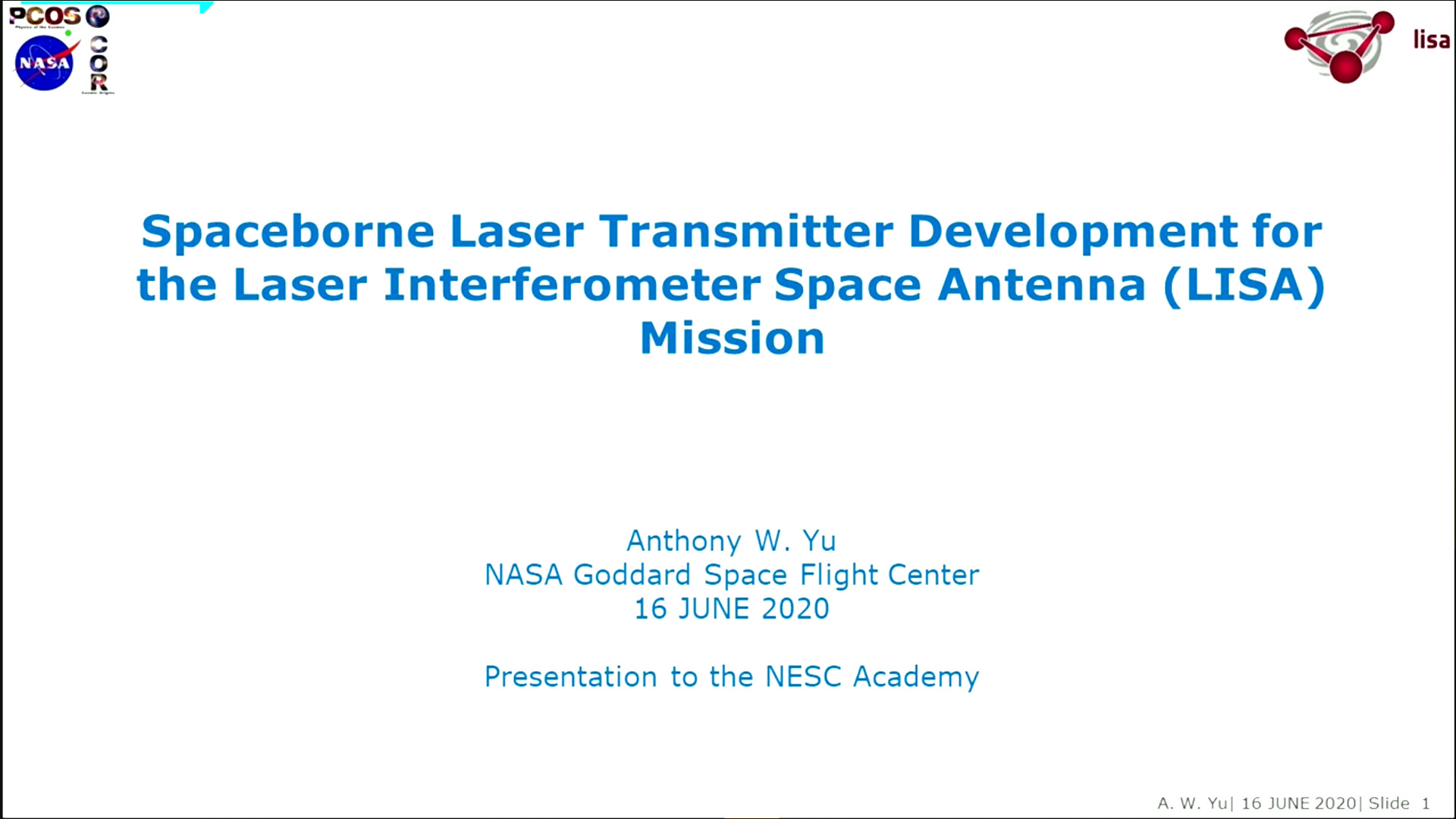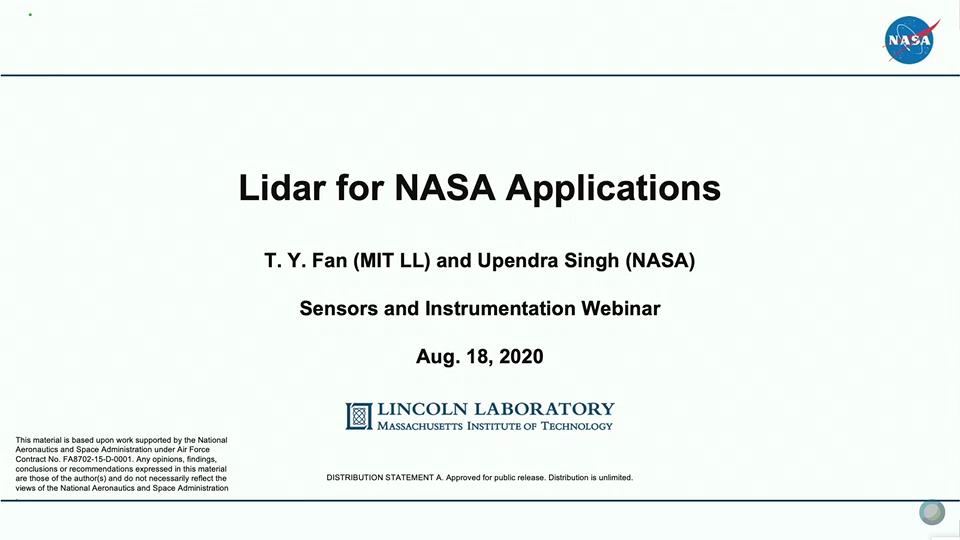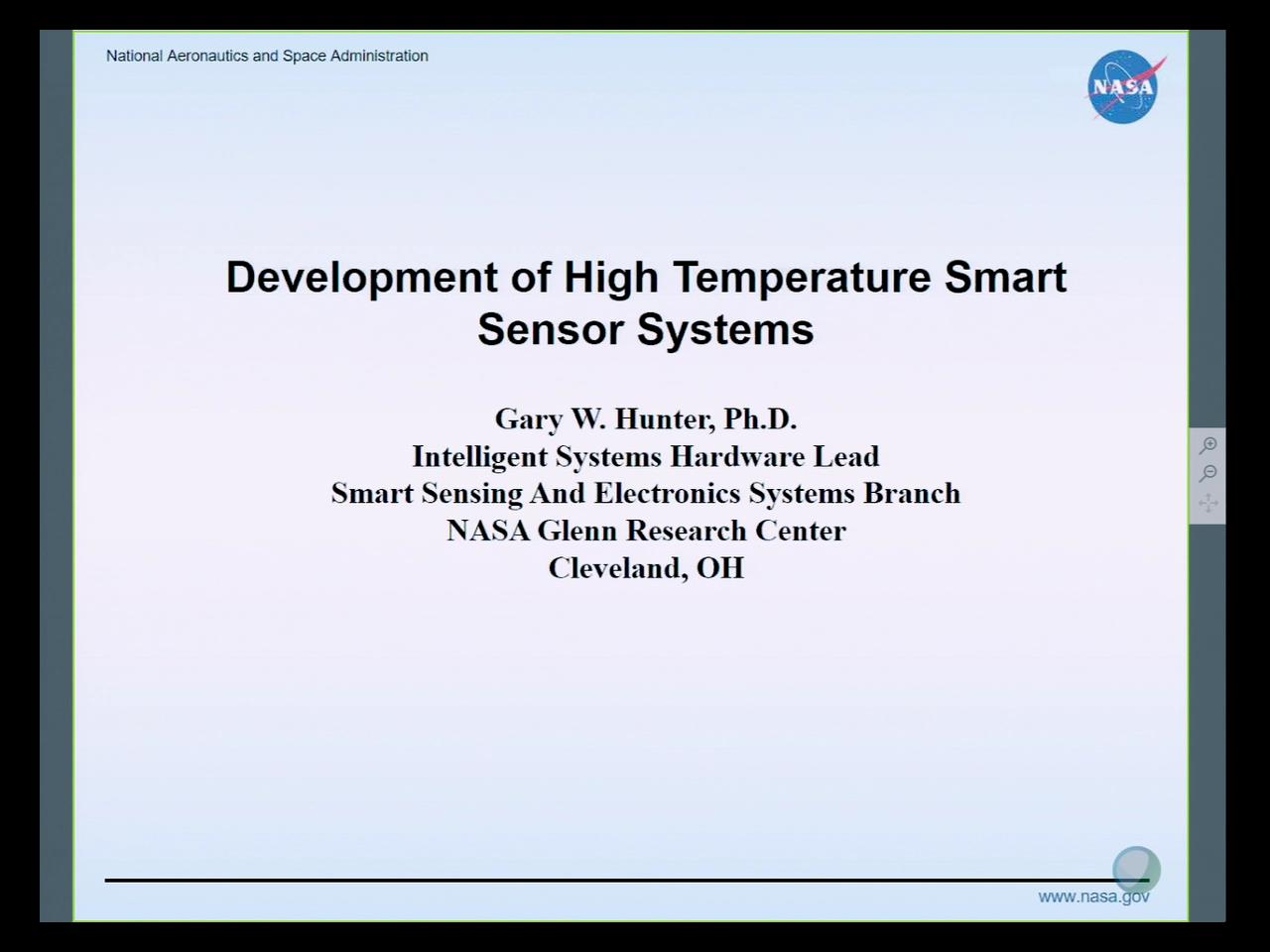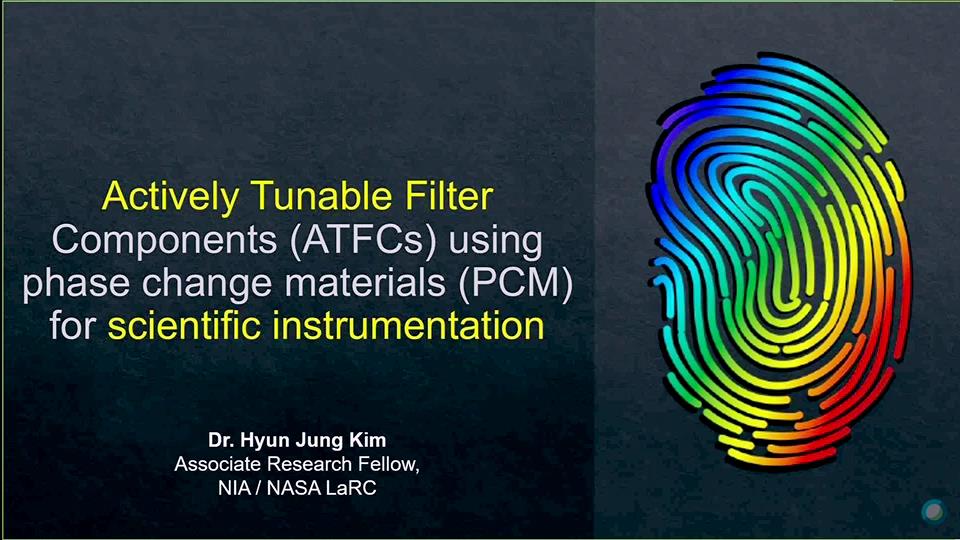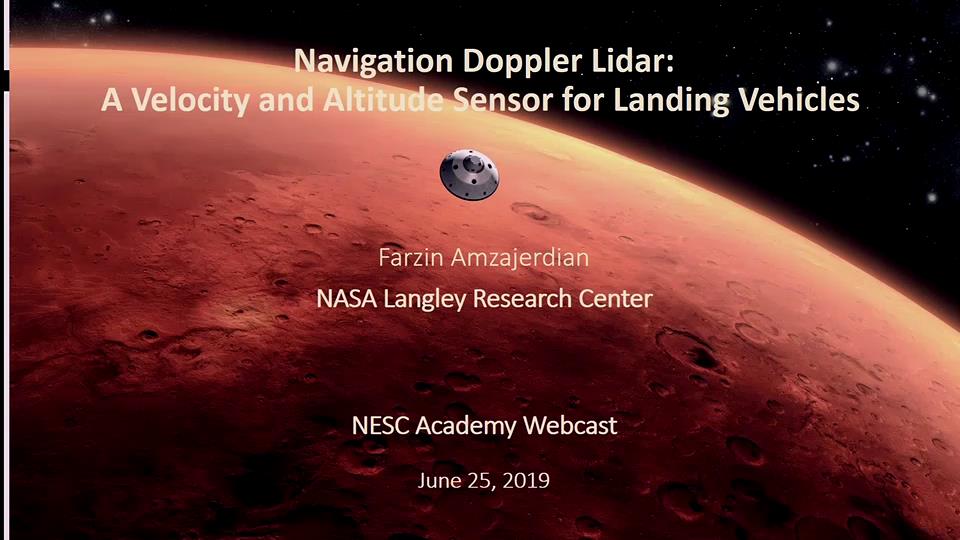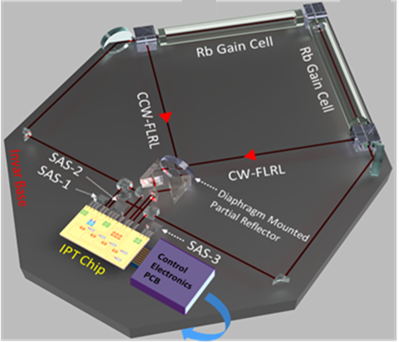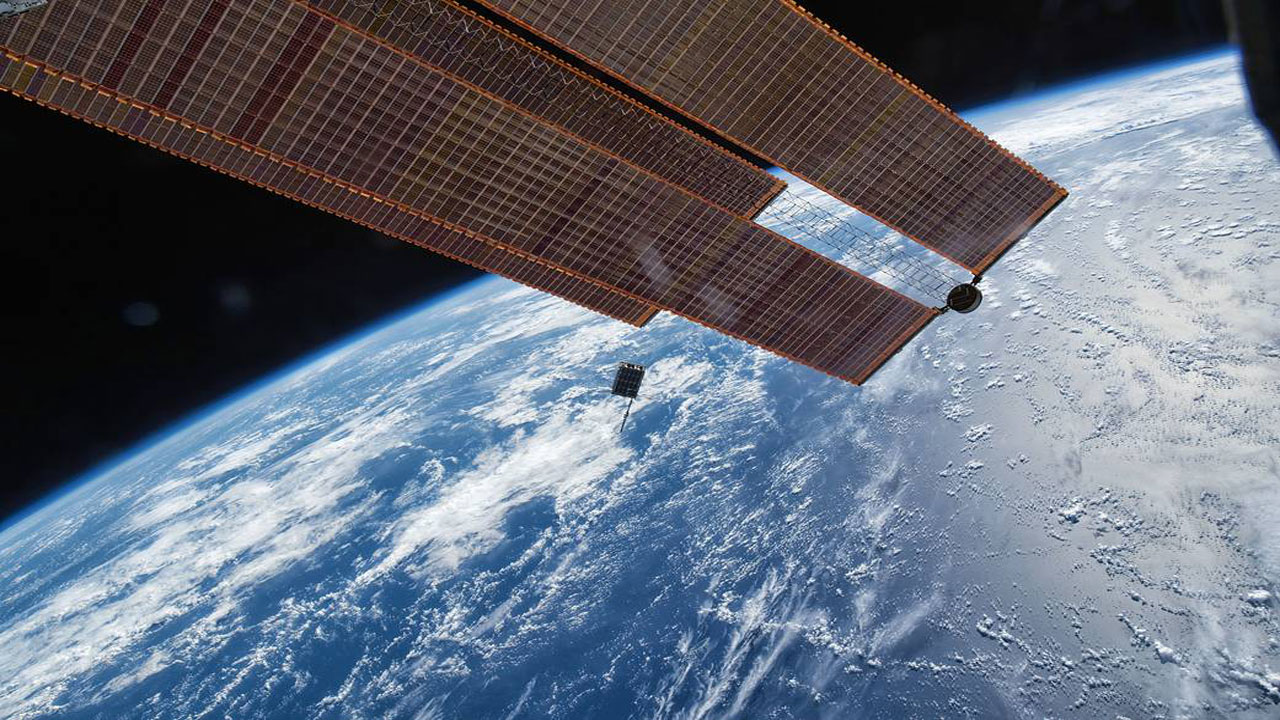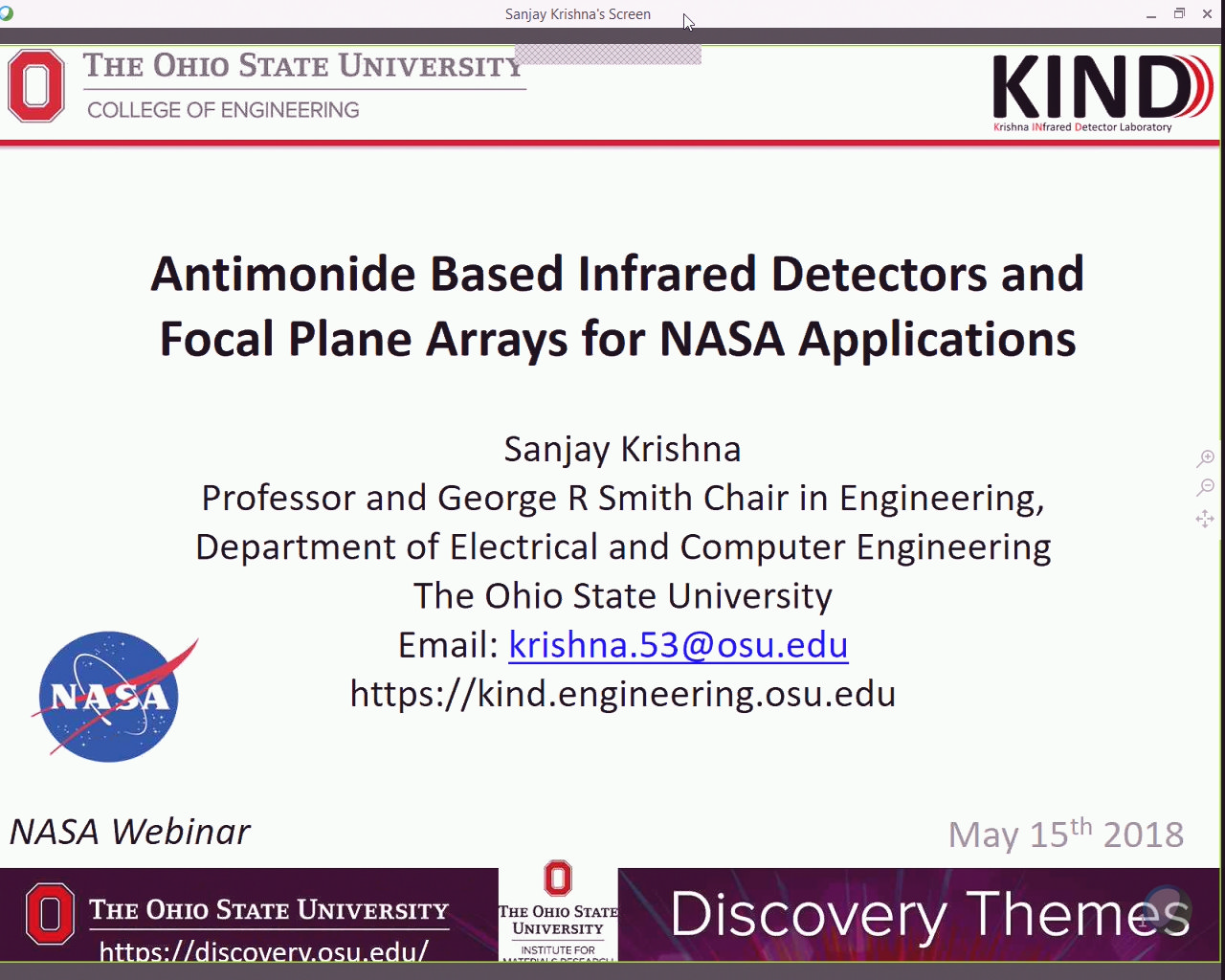Sensors & Instrumentation
32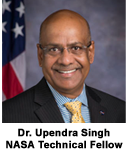
These training modules were compiled by the Sensors & Instrumentation Technical Discipline Team (TDT).
Upcoming Webcasts
TBD
Checking for webcasts...
How Type-II Superlattice (T2SL) Focal Planes Changed the Infrared Landscape
| Presenter | Sarath D Gunapala |
|---|---|
| Published | February 2024 |
| Recorded | February 2024 |
| Duration | 53:43 |
| Tags | None |
Abstract:<br>In this presentation, Sarath Gunapala will discuss his experience as a technologist (developing novel infrared detectors/ focal plane arrays for various remote sensing applications) and how T2SL focal plane array technology has changed the Infrared Landscape.<br><br>About the Speaker: <br>Sarath D. Gunapala received a First Class Honors BSc in physics from the University of Colombo, Sri Lanka in 1980, and an MS and PhD in Physics from the University of Pittsburgh in 1986. In his early years of research, Sarath worked on opto-electronic devices at Bell Communication Research and AT&T Bell Laboratories in Murray Hill, New Jersey. Later he joined NASA’s Jet Propulsion Laboratory in Pasadena, California where he is a Fellow, Senior Research Scientist and a Principal Member of the Engineering Staff. Sarath has authored over 350 journal publications, 14 book chapters, and holds 27 U.S. patents. He has received numerous awards including the NASA Outstanding Leadership Medal, NASA Exceptional Engineering Achievement Medal, Career Achievement Award from U.S. Army/RDECOM/CERDEC, IEEE Aron Kressel Award, Military Sensing Symposia (MSS) Herschel Award, MSS Levinstein Award, SPIE George Goddard Award, and was inducted to United States Space Technology Hall of Fame 2001. He is also a fellow member of IEEE, SPIE, and Optica.
Common Applications for Acoustic Emission Testing (AET)
| Presenter | Steven Garcia |
|---|---|
| Published | January 2024 |
| Recorded | January 2024 |
| Duration | 39:55 |
| Tags | #Intermediate, .Testing |
Abstract:<br>Acoustic Emission Testing (AET) is a powerful non-destructive evaluation technique used across various industries to assess the structural integrity of materials and components under stress. This method involves detecting and analyzing transient stress-induced waves or signals emitted by materials when subjected to external forces. AET serves as a valuable tool for monitoring the behavior of materials, detecting defects, and predicting potential failures in diverse structures ranging from pipelines and bridges to aerospace components<br><br>About the Speaker:<br>Mr. Garcia has done extensive work in the area of Fitness for Service using Acoustic Emission testing, including mechanical integrity assessments of ASME pressure vessels, pre-service proof testing, requalification testing, in-service monitoring, leak detection and location for LNG service facilities, above ground storage tank inspections and general fitness-for-service applications of reactors, pressure vessels, piping and other components related to refineries and chemical plants in several countries around the world. Mr. Garcia has done extensive acoustic emission testing and laser scanning of refinery coke drums for the past several years. Work experience also includes composite pressure vessel (COPV) testing for major aerospace companies. Mr. Garcia has provided project support to senior engineering staff for field engineering/testing using high-speed data acquisition systems in remote locations. Mr. Garcia also has experience in vibration monitoring and field metallography related to refinery/chemical plant services.<br>
Modular Damage Detection For Expandable Structures
| Presenter | Mark L Lewis |
|---|---|
| Published | October 2023 |
| Recorded | October 2023 |
| Duration | 54:37 |
| Tags | #Advanced, .Systems / Subsystems, ~Damage Detection, ~Health Management, ~Expandable Structures, ~Meteoroid Sensing, ~Health Monitoring, ~Composite Materials |
Abstract:<br>The 2020 CIF funded Modular Composite Damage Detection System (MCDDS) aims to advance the technology of damage detection in composites in the areas of thin, flexible damage detection panel construction, encapsulation techniques in composite matrixes, innovative integration and interfacing techniques with flexible embedded sensory panels, repair methods of composite materials, and improved packaging of the MCDDS. <br><br>Bio's:<br>Mark Lewis received a B.S. in Electrical Engineering from Cleveland State University. Mr. Lewis has over 30 years of experience at NASA and currently serves as the Technical Integration Manager for Moon to Mars activities in Exploration Research & Technology Programs at KSC. Mr. Lewis began his career at NASA Glenn Research Center (GRC) as an electrical engineer providing avionics, electronics, instrumentation, and software design support for many spaceflight payload experiments. Later, Mr. Lewis transferred to KSC and served as a Ground Support Equipment (GSE) Project Engineer for the Space Shuttle Program. He has extensive systems engineering and integration expertise and research experience developing damage detection, health management, and robotic systems at KSC. He has flight hardware development experience including satellite servicing and microgravity physical science experiments. Mr. Lewis is listed as an inventor on seven patents.<br><br>Tracy L. Gibson received the B.S. in chemistry from the University of Southern Indiana, Evansville, Indiana in 1992 and the Ph.D. in chemistry from Florida Institute of Technology, Melbourne, Florida in 1999. <br>Since 2003 he was worked as a contractor at Kennedy Space Center and is currently a Subject Matter Expert 2 for the Laboratory Support Services and Operations II Contract. He has supported numerous research projects, including projects related to materials development and in-situ resource utilization and has research experience in developing methods for the capture and processing of the Martian atmosphere and converting waste products into fuels. He also has research experience in the development of self-healing materials for aerospace applications, novel magnetic materials, damage detection systems, as well as development of systems for intelligent thermal management. He has extensive experience in sensor development and testing. He holds multiple U.S. Patents and is also listed as an innovator on more than 90 NASA New Technology Reports.<br><br>Dr. Gibson has received numerous awards while at Kennedy Space Center, including the NASA STS-115 Space Flight Awareness Launch Honoree Award in 2006, NASA KSC Engineer/Scientist of the Year Award, Contractor Category in 2009, the NASA Exception Public Service Medal in 2010, the NASA Silver Achievement Medal in 2014, and the 2020 Outstanding Chemical Professional, Orlando Section of the American Chemical Society.<br> <br><br><br><br>
The Path to Detecting Extraterrestrial Life With Astrophotonics
| Presenter | Nemanja Jovanovic |
|---|---|
| Published | September 2023 |
| Recorded | September 2023 |
| Duration | 01:01:24 |
| Tags | None |
Abstract:<br>Astrophysical research into exoplanets has delivered thousands of confirmed planets orbiting distant stars. These planets span a wide range of size and composition, with diversity also being the hallmark of system configurations, the great majority of which do not resemble our own solar system. Unfortunately, only a handful of the known planets have been characterized spectroscopically thus far, leaving a gaping void in our understanding of planetary formation processes and planetary types. To make progress, astronomers studying exoplanets will need new and innovative technical solutions. Astrophotonics -- an emerging field focused on the application of photonic technologies to observational astronomy -- provides one promising avenue forward. In this paper we discuss various astrophotonic technologies that could aid in the detection and subsequent characterization of planets and in particular themes leading towards the detection of extraterrestrial life.<br><br>About the Speaker:<br> Nemanja Jovanovic received his Ph.D. in laser physics from Macquarie University in 2010. He worked as a postdoc. on astrophotonics at the Australian Astronomical Observatory until 2012. He moved to Subaru Telescope where he was part of the SCExAO high contrast exoplanet imaging instrument team until 2017. Currently, Nemanja is the Optics and Systems Group Lead at Caltech developing advanced exoplanet instruments for the largest ground based telescopes while leading several technical developments in astrophotonics.
Bigelow Expandable Activity Module (BEAM) ISS Distributed Impact Detection System (DIDS)
| Presenter | Nathan Wells |
|---|---|
| Published | August 2023 |
| Recorded | July 2023 |
| Duration | 01:02:36 |
| Tags | None |
Abstract:<br>Expandable modules for use in space and on the Moon or Mars offer a great opportunity for volume and mass savings in future space exploration missions. This type of module can be compressed into a relatively small shape on the ground, allowing them to fit into space vehicles with a smaller cargo/fairing size than a traditional solid, metallic structure-based module would allow. In April 2016, the Bigelow Expandable Activity Module (BEAM) was berthed to the International Space Station (ISS). BEAM is the first human-rated expandable habitat/module to be deployed and crewed in space. BEAM was developed as a NASA managed ISS payload project in partnership with Bigelow Aerospace. BEAM has been installed on ISS for a total of 8 years although initially was intended to only stay attached to ISS for an operational period of 2 years to help advance the technology readiness for future expandable modules. BEAM has been instrumented with a suite of space flight certified sensors systems which will help characterize the module’s performance for thermal, radiation shielding and impact monitoring against potential Micro Meteoroid/Orbital Debris (MM/OD) providing fundamental information on the BEAM environment for potential health monitoring requirements and capabilities. <br><br>This presentation will focus on the Distributed Impact Detection System (DIDS) which is actively being utilized 24/7 for MM/OD impact detection. This will provide an overview of how the sensors/instrumentation systems were developed, tested, installed and an overview of the current sensor system operations and how its data is being reviewed on the ground by the ISS loads and dynamics team.<br><br>Presenter Bio:<br>Nathan Wells currently serves as the Instrumentation Technical Discipline Lead for the Avionic Systems Division at the Johnson Space Center (JSC) in Houston, Texas where he supports the International Space Station (ISS) Program for various Structural Health Monitoring systems as well supporting the Gateway Program as a Project Manager for development/testing work of a Time Triggered Ethernet Network for Northrop Grumman in their Habitation and Logistics Outpost (HALO) module design. In his capacity he also serves as a JSC representative for the NESC Sensor and Instruments Technical Discipline Team and is deputy lead for the NESC In-Situ and Proximity Community of Practice. Nathan earned his Bachelor of Science degree in Aerospace Engineering from Embry-Riddle Aeronautical University (ERAU) and completed studies for a Master of Science degree in Technical Management in a Technical Position. His past work involved working on various International Space Station (ISS) countermeasures/exercise device projects serving as a project engineer and project manager as well as serving as the Project Manager for a Shuttle Program Return to Flight project called the “Wing Leading Edge Impact Detection System” (WLEIDS) between 2007-2011 and working as the lead Development Flight Instrumentation (DFI) engineer for the Morpheus project between 2010 and 2013. Nathan has received numerous awards and honors including the NASA Exceptional Achievement Medal in 2016 and Silver Snoopy Award in 2021.<br><br>Aaron Trott is a Program Director who has been employed with Invocon, Inc. for over twenty-seven years. His present roles include product manager for launch vehicle control systems and project manager for aerospace data acquisition systems. Other activities include business development, research & development, and systems engineering. Specific focus areas are instrumentation system developments for applications in the aerospace industry. Aaron earned his Bachelor’s and Master’s Degrees in Electrical Engineering from Mississippi State University, during which time he participated in the cooperative education program at NASA Langley Research Center. During his graduate studies, he also worked at the National Science Foundation Engineering Research Center for Computational Field Simulation.
X-Ray Vision: Exploring The Hidden Universe
| Presenter | Dr. Jessica Gaskin |
|---|---|
| Published | July 2023 |
| Recorded | February 2023 |
| Duration | 01:00:32 |
| Tags | None |
Abstract:<br>NASA's goal in Astrophysics is to "Discover how the universe works, explore how it began and evolved, and search for life on planets around other stars." Addressing this ambitious goal requires a large astrophysics fleet that is capable of observing the universe in multiple wavelengths. This talk will focus on our ability to view X-rays emanating from some of the most extreme environments in space using full-shell grazing incidence optics flying on suborbital and space-based platforms.
Development of a Portable Unit for Metabolic Analysis (PUMA)
| Presenter | Dr. Daniel Dietrich |
|---|---|
| Published | May 2023 |
| Recorded | April 2023 |
| Duration | 58:10 |
| Tags | None |
Abstract:<br>Understanding an individual’s metabolic rate is important in a wide range of terrestrial and extraterrestrial applications. For extraterrestrial applications, devices to measure metabolic rate should be compact, low power, and require little maintenance and/or calibration. This presentation discusses the effort to develop a new portable metabolic device (PUMA - Portable Unit for Metabolic Analysis) at the NASA Glenn Research Center. PUMA is a battery-operated, wearable unit to measure metabolic rate (minute ventilation, oxygen uptake, carbon dioxide output and heart rate) in a clinical setting, in the field or in remote, extreme environments. The critical sensors in PUMA that measure oxygen, carbon dioxide and ventilatory flow are located close to the mouth and sampled at 10 Hz to allow intra-breath measurements. The engineering efforts to develop PUMA will be presented, followed by limited validation studies of the final device. Finally, the application of PUMA and the underlying technologies for a range of applications will be presented.
Sensors Used For Hot Fire Testing of Rocket Engines
| Presenter | Pablo Gomez |
|---|---|
| Published | March 2023 |
| Recorded | February 2023 |
| Duration | 01:00:38 |
| Tags | None |
Abstract:<br>Rocket engines and their components are tested to validate models and reduce mission risks. The quality of the data collected largely depends on the types of signal conditioning and sensors used in the process. Since the 1960's, Stennis Space Center (SSC) has been NASA's leading center for testing Rocket Stages, Rocket engines and rocket engine components. Throughout this time, SSC has developed best practices on how to deal with sensor shortcomings and increase their reliability. This paper explains the operation of the most common sensors used, their pros and cons, and their uncertainties. Additionally, it covers the in-place calibration of the facility propellant flowmeters which cannot be removed and sent to be calibrated at a lab on a regular basis.
Microfluidic Sensing Systems to Study and Seek Microbes Beyond Earth
| Presenter | Dr. Antonio Joseph Ricco |
|---|---|
| Published | January 2023 |
| Recorded | December 2022 |
| Duration | 01:01:19 |
| Tags | None |
Abstract:<br>We develop miniaturized integrated bio/analytical instruments and platforms to conduct economical, frequent, autonomous life-science experiments in outer space. The technologies of our multiple “free-flyer” cubesat missions are the basis of a rapidly growing suite of miniaturized biologically- and chemically-oriented instrumentation now enabling a new generation of in-situ space science experiments. Over the past decade, our missions have included studies of space-environment-related changes in gene expression, drug dose response, microbial longevity and metabolism, and the degradation of biomarker molecules. The science and technology of the GeneSat (2006) and BioSentinel (2022, via Artemis-1) missions will be highlighted in the context of conducting biological and chemical experiments in outer space using miniaturized integrated systems.<br> We also adapt and apply our spaceflight-compatible microfluidic and bioanalytical technologies to the challenge of finding molecular and structural indications of microbial life on the so-called icy worlds of our solar system, particularly the moons Enceladus and Europa. The Sample Processor for Life on Icy Worlds (SPLIce) system, a microfluidic sample-processing “front end” to enable autonomous detection of signatures of life and measurements of habitability parameters on icy worlds, will be described. SPLIce is under development to support several mission scenarios, including a fly-through of Enceladus’ icy plumes, expected to yield ~ 2 µL of ice particles, and a Europan lander, the sampling system of which is anticipated to deliver 1 – 5 mL of icy solids for analysis. <br>
The Europa Lidar Sensor Assembly
| Presenter | Luke Skelly |
|---|---|
| Published | November 2022 |
| Recorded | November 2022 |
| Duration | 53:30 |
| Tags | #Fundamental, .Analysis / Modeling and Simulation, .Hardware, ~Europa Lidar Sensor Assembly, ~Multi-Function Lidar, ~Europa, ~Entry, Descent, and Landing, ~Single-Photon |
Abstract:<br>The Europa Lidar Sensor Assembly (ELSA) is a multi-function lidar for landing on objects in our solar system of which we have limited topographic knowledge. Europa is an example object of high interest due to the hypothesis that a water ocean hides beneath its icy surface and possibly containing evidence of life; however, existing images of its surface we have are low-resolution, making it difficult or impossible to plan a safe landing. The ELSA system being presented is designed to provide altimetry from 10 kilometers to 10 meters, a coarse Digital Elevation Model (DEM) generated at a 5-kilometer elevation for site selection, and fine DEM generated at a 500-meter elevation for hazard avoidance. ELSA utilizes a radiation hardened single photon sensitive Geiger-mode Avalanche Photodiode (GmAPD) array of detectors, dual green lasers with sub-nanosecond pulsewidth, and real-time Field-programmable Gate Array (FPGA) processing. Progress on the brassboard design and build, scheduled for field testing next year, will be presented.
Sensors and Instrumentation for Aeroacoustic Noise Characterization and Assessment
| Presenter | William M. Humphreys |
|---|---|
| Published | August 2022 |
| Recorded | July 2022 |
| Duration | 01:01:43 |
| Tags | #Fundamental, .Testing, .Hardware, ~Acoustic Testing, ~Aircraft Acoustic Noise Characterization, ~Microphone Phased Array |
Abstract:<br>Experimental aeroacoustic testing has undergone a radical transformation over the last 25 years with the development of novel microphone phased array measurement systems. These phased arrays are now routinely used in wind tunnel testing to identify the source and strength of radiated noise generated by aerodynamic models. They are also increasingly being used for the characterization of generated noise in full-scale flyover flight testing. This webcast will give an overview of the fundamentals of microphone phased array measurements. Examples of both ground test and flight campaigns will be given where the microphone array was the primary sensor system used to collect information regarding baseline acoustics and the effectiveness of noise reduction treatments for subsonic fixed-wing airframes.
Lidar Sensing and Coherent Imaging Research in Montana
| Presenter | Dr. Krishna Rupavatharam |
|---|---|
| Published | June 2022 |
| Recorded | June 2022 |
| Duration | 59:25 |
| Tags | #Fundamental, .Hardware, ~Coherent Doppler LIDAR, ~Altitude Sensor, ~Navigation Doppler LIDAR, ~EDL, ~Remote Sensing, ~Sensors and Instrumentation, ~Machine Learning, ~Lidar |
Abstract:<br>Optics and photonics related research, primarily performed at Montana State University, Bozeman, MT, has focused on the development of novel lidar sensing modalities and coherent imaging techniques. This has resulted in the growth of lidar based companies in Montana, that develop products for a variety of applications ranging from self-driving cars to remote gas sensing. A brief preview of the evolution of lidar research in Montana as well the development of innovative applied research enabling commercialization will be presented.<br>
Development of a Venus Surface Wind Sensor
| Presenter | John Wrbanek |
|---|---|
| Published | May 2022 |
| Recorded | April 2022 |
| Duration | 48:19 |
| Tags | #Fundamental, .Testing, .Hardware, .Environments, ~Wind Velocity Sensors, ~Atmospheric Structure and Dynamics, ~Drag-Force Anemometer, ~Harsh |
Abstract:<br>To better understand the atmospheric structure and dynamics on the Venus surface and provide input to climate models, there is a need to measure the wind velocity and direction on the surface and track changes over extended periods. A wind sensor based on a miniature drag-force anemometer is being developed to meet the challenges for wind measurements and operational requirements on the surface of Venus. The sensor materials are chosen to enhance durability and prevent reactivity with the Venus surface atmosphere. Advantages of this approach include that it is independent of variable heat transfer, has been matured in other harsh environment applications, and has a low mass and power requirement. Prototype drag-force anemometers were demonstrated, integrated with a high-temperature operational amplifier, recording transient effects in a simulated Venus surface environment. For multidirectional wind monitoring, the sensors are small enough to be deployed orthogonally as a three-dimensional array on a small arm or mast. This presentation describes the development and demonstration of this miniature drag-force anemometer integrated with high temperature electronics in a simulated Venus surface environment.
Entry, Descent, and Landing Instrumentation
| Presenter | Jose Santos |
|---|---|
| Published | April 2022 |
| Recorded | April 2022 |
| Duration | 01:07:10 |
| Tags | #Fundamental, .Analysis / Modeling and Simulation, .Hardware, .Systems / Subsystems, ~Thermal Protection System, ~Vibration Testing, ~Instrumentation Suit, ~Entry, ~Descent, ~Landing Instrument Suite |
The Entry, Descent, and Landing (EDL) phase of a scientific mission to a planetary body involving atmospheric flight is critical because the spacecraft must survive the extreme environment it encounters as it traverses the atmosphere. Mission designers must ensure the spacecraft's Thermal Protection System (TPS) can adequately protect the spacecraft, and the scientific payloads it carries. The EDL sequence is often regarded to be among the riskiest parts of the mission because there is little to no opportunity to take corrective action if a problem or anomaly is encountered. The Thermal Protection System is a single point of failure, and its design involves a robust sizing and margins process. Engineering instrumentation embedded within the Thermal Protection System provides valuable flight data to support verification and validation of analysis and simulation tools that are used for TPS design. <br><br>This presentation will give an overview of in-situ EDL instrumentation used in atmospheric entry vehicles. Examples of different sensor types and recent instrumentation flown on NASA missions within the past decade will be presented, including the instrumentation suites flown on the Mars Science Laboratory, Mars 2020, and Orion Exploration Flight Test-1 missions. In addition, instrumentation that will fly on the Artemis 1 and 2, and Dragonfly missions will be described. Furthermore, sensor measurement accuracy and/or resolution for the current state-of-the-art, along with future needs, will also be discussed.
Thermal InfraRed Sensor (TIRS)-2 Instrument Development
| Presenter | Synthia Tonn |
|---|---|
| Published | March 2022 |
| Recorded | March 2022 |
| Duration | 57:28 |
| Tags | #Fundamental, .Hardware, ~Thermal Infrared Sensors, ~TIRS-2, ~Thermal Imaging Sensors, ~Geo-Located Thermal Image Data |
The Thermal InfraRed Sensor (TIRS)-2 instrument is a two-band thermal imaging sensor flying on Landsat 9. Like its predecessor TIRS on Landsat 8, TIRS-2 produces radiometrically calibrated, geo-located thermal image data used operationally to monitor water consumption on a field-by-field basis in the U.S. West and internationally, among multiple other uses. This talk will provide an overview of the instrument and how it operates.
Printed Devices for On-Demand Manufacturing for Electronics
| Presenter | Jin-Woo Han |
|---|---|
| Published | February 2022 |
| Recorded | January 2022 |
| Duration | 56:40 |
| Tags | #Fundamental, .Materials, .Hardware, ~Sensors, ~In-Space Manufacturing, ~Printed Devices |
In Space manufacturing (ISM) is an ongoing activity aimed at on demand manufacturing of various active and passive components and spare parts. NASA has already been operating 3D printers in the International Space Station (ISS) and plans are underway to create the capabilities for 2D printing. In this talk, the on-demand printed electronics activities as a part of NASA ISM program will be presented. <br><br>An overview of our emerging printed devices including gas sensors, energy storage devices, triboelectric nanogenerators and others will be provided. In addition to printing, devices and integration of the devices into systems, tool development is receiving attention, rightfully so in order to meet the anticipated demands of internet of things (IoT).
Overview of On Demand Manufacturing of Electronics on the ISS
| Presenter | Curtis Hill |
|---|---|
| Published | January 2022 |
| Recorded | December 2021 |
| Duration | 55:33 |
| Tags | #Fundamental, .Materials, ~In-Space Manufacturing, .Other, ~On-Demand Manufacturing of Electronics, ~Long-Term Habitation, ~3D Printers |
On Demand Manufacturing of Electronics (ODME) is a project that is part of NASA’s In Space Manufacturing suite of projects that is developing on-demand manufacturing capability for the International Space Station and beyond. These capabilities will include on demand manufacturing of metals, electronics, sensors, and the ability to reclaim and recycle for long-term sustainment. ODME is developing new materials and processes for additively manufacturing electronics and sensors in a microgravity environment. The new capabilities will allow NASA to replace and upgrade existing electronic components, and also upgrade systems and sensor networks with on-demand printing capabilities. This is an enabling capability for long-term habitation as well as long-range space missions.<br><br>
Integrated Photonics and Nanophotonic Devices Using Transparent Conductive Oxides
| Presenter | Alan Wang |
|---|---|
| Published | September 2021 |
| Recorded | August 2021 |
| Duration | 47:07 |
| Tags | #Intermediate, .Materials |
Transparent conductive oxide (TCO) materials have attracted tremendous research interests for integrated photonics and nanophotonic devices in recent years due to the extraordinary perturbation to the refractive indices achieved either through oxygen vacancy doping or electrical gating. In addition, high quality TCO materials can be deposited using DC- or RF-sputtering on various substrates. Therefore, TCO materials promise unprecedented potentials for heterogeneous integration with silicon photonic integrated circuits (PICs) and nanophotonic platforms. <br><br>In this talk, I will review recent research progress in my group for the development of TCO-gated silicon photonic devices to achieve ultra-high energy efficiency, high speed photonic devices, including photonic crystal nanocavity modulators and microring resonators with ultra-large E-O tuning efficiency. We also achieved 5Gbit/s E-O modulation speed and will also discuss the strategy to further improve the energy efficiency to atto-joule/bit and implement large-scale integration for data centers. TCO based metasurface devices will also be discussed with envisioned applications in optical filtering and beam control.
Accelerating the Innovation Cycle of Nanophotonic Systems Design
| Presenter | Dr. Jonathan Fan |
|---|---|
| Published | August 2021 |
| Recorded | August 2021 |
| Duration | 55:14 |
| Tags | #Advanced, .Analysis / Modeling and Simulation, .Design, ~Machine Learning, ~Nanophotonics, ~Simulations to Design Photonic Systems, ~Optical Systems |
Abstract:<br>The general process for nanophotonics systems innovation involves identifying/generating a new concept, proposing a device design that can capture the concept, and validating the device design with an electromagnetic simulator. The latter two steps are typically performed iteratively by a researcher with specialized domain knowledge until a satisfactory device is identified, thereby requiring significant expenditure in time and computational cost. We will discuss computational algorithms based on deep neural networks that can accelerate the design and simulation of nanophotonic devices. <br><br>We will discuss the use of generative networks to perform population-based optimization and elucidate how the neural network architecture can be tailored to effectively search for the global optimum in a non-convex design landscape. We will also discuss how physics-informed deep networks can be trained with a combination of data and physical constraints to serve as accurate surrogate electromagnetic solvers. We anticipate that the ability for deep learning models to accelerate and even automate the simulation and design of photonic systems will push the innovation cycle of photonics research in academia and industry.<br>
Open Circuit Resonant (SansEC) Sensor Technology Applications
| Presenter | George Szatkowski |
|---|---|
| Published | July 2021 |
| Recorded | June 2021 |
| Duration | 43:03 |
| Tags | #Fundamental, .Testing, .Materials, .Hardware, ~Lightening Mitigation, ~Composites, ~Wearable Technologies, ~Aircraft Composites, ~Virtual Sensors |
Abstract:<br>Mr. Szatkowski will present his research pertaining to the design and measurement of open circuit electromagnetic resonant sensors (SansEC) for composite aircraft applications. The talk will also touch on other application areas where SansEC sensor technology could play a role in meeting future NASA measurement requirements and commercialization opportunities.
Challenges Measuring Atmospheric Composition of Giant Planets
| Presenter | Dr. Kunio Sayanagi |
|---|---|
| Published | June 2021 |
| Recorded | May 2021 |
| Duration | 55:59 |
| Tags | #Fundamental, .Analysis / Modeling and Simulation, ~Small Next-Generation Atmospheric Probe, ~Atmospheric Composition Instruments, ~Tunable Laser |
This presentation will focus on the Small Next-generation Atmospheric Probe (SNAP) design developed in partnership by Hampton University and NASA Langley Research Center to enable delivery of multiple probes. Using SNAP as a reference design, key instrument trades and the state of the art in the atmospheric composition instruments will also be discussed.<br><br>
Electromagnetic Thermocouple (TC) Anomaly Mechanisms During Atmospheric Entry
| Presenter | Dr. Magnus Haw |
|---|---|
| Published | April 2021 |
| Recorded | May 2021 |
| Duration | 50:27 |
| Tags | #Intermediate, .Analysis / Modeling and Simulation, .Testing, .Hardware, ~Thermal Protection System, ~Thermocouples, ~Diagnostic Sensors, ~Atmospheric Entry, ~Hypersonic Wind |
Thermocouples (TCs) are a critical diagnostic sensor for high enthalpy environments including Thermal Protection Systems (TPS) for atmospheric entry, hypersonic wind tunnels, and arc jet test facilities. They are used for both evaluating facility environmental conditions (enthalpy, and heat flux) as well as for measuring in-situ material thermal response under test conditions (thermal conductivity, heat capacity, etc.). Consequently, accurate TC measurements are fundamental for both material and facility Verification and Validation (V&V). However, a number of electromagnetic TC anomalies have been observed in both ground tests and flight instrumentations. These anomalies are caused via various coupling mechanisms: surface voltage coupling, Hall effect currents, and RF rectification. All of these mechanisms can, if unaddressed, result in obviously compromised results or worse, non-physical measurements which appear reasonable. This talk will provide an overview of each of these anomaly mechanisms and discuss ongoing efforts to quantify and mitigate them.<br><br>
CAL: NASA’s Cold Atom Lab Operating Onboard the ISS
| Presenter | Dr. Jason Williams |
|---|---|
| Published | March 2021 |
| Recorded | February 2021 |
| Duration | 43:58 |
| Tags | #Fundamental, .Analysis / Modeling and Simulation, .Operations, ~Cold Atomic Lab (CAL), ~ISS, ~Atom Interferometry, ~Weak Equivalence Principle, ~Gravity Waves, ~Dark Matter, ~Dark Energy |
Abstract:<br>The Cold Atom Lab (CAL) launched to the International Space Station in May 2018, and has been operating since then as the world’s first multi-user facility for the study of ultra-cold atoms in space. The unique microgravity environment of the ISS allows researchers to achieve exceptionally low temperature gases, to study and utilize their quantum properties in an environment free from the perturbing force of gravity, and to observe and interact with these gases in the essentially limitless free-fall of orbit. A recent upgrade to CAL has also enabled the study of atom interferometry (AI) in space. Precision spaceborne AIs are expected to become an enabling quantum technology for a variety of fundamental and applied physics research areas which range from novel tests of the validity of the weak equivalence principle, measurements of the fine structure and gravitational constants, and detection of gravity waves and dark matter/dark energy, to next-generation accelerometers and rotation sensors for advanced PNT capabilities. We will discuss our efforts at JPL to provide pioneering, microgravity enabled quantum gas research capabilities with CAL, to demonstrate AI for the first time in space, and to mature this technology for future mission opportunities. The impact from this work, and potential for follow-on studies, will also be reviewed in the context of future space-based fundamental physics missions. This research was carried out at the Jet Propulsion Laboratory, California Institute of Technology, under a contract with the National Aeronautics and Space Administration.
Spaceborne Laser Transmitter Development for the Laser Interferometer Space Antenna (LISA) Mission
| Presenter | Anthony Yu |
|---|---|
| Published | January 2021 |
| Recorded | May 2020 |
| Duration | 56:04 |
| Tags | #Intermediate, .Analysis / Modeling and Simulation, .Hardware, ~Gravitational Wave Observatory, ~LISA, ~Interferometer, ~Master Oscillator Power, ~Space-Based Lasers |
The Laser Interferometer Space Antenna (LISA) is a partnership between the European Space Agency (ESA) and NASA to build a Gravitational Wave (GW) observatory. The observatory, which consists of a three-spacecraft constellation with a nominal separation of 2.5 million km between each spacecraft, provides a tool for scientists to directly detect gravitational waves generated from various astronomical phenomena in a waveband that is not accessible from Earth. NASA is developing laser transmitters as one of the potential US contributions to LISA. The NASA laser design leverages lessons learned from previous flight missions, and includes the latest technologies in photonics packaging and reliability engineering to ensure a laser lifetime of 16 years covering integration and test through a possible extended mission phase. <br><br>The laser system is one of the most important components of the LISA measurement system, since it will provide the light used to make the sensitive interferometric distance measurement between the spacecraft. We at the NASA GSFC have been developing a highly stable and robust master oscillator power amplifier (MOPA) laser system for LISA since 2018. The MOPA architecture entails two major subsystems – (i) the master oscillator (MO), a lower power laser that meets majority of the laser requirements except power; and (ii) the power amplifier (PA), which boosts the low output power of the MO to the required power without imparting additional noise. Our laser design philosophy is driven by LISA’s unique requirements arising from its role in the extremely long-baseline interferometric measurement system. It must have exquisite stability in both wavelength (which requires active stabilization using a high finesse optical cavity) and intensity (which requires active stabilization for long-term drifts and quantum-limited performance over short time scales). In addition the laser must be robust enough to survive the 16 years of operation from early ground testing through the extended mission phase. <br><br>The unique LISA requirements make evaluation of the laser performance challenging. To enable testing of these lasers, we built a unique laser characterization infrastructure that does not exist in industry, other Government labs, or academia. These in situ test capabilities provide important advantages including: time savings, cost savings, and improved ability to meet compliance requirements. <br><br>In this talk we will discuss the NASA GSFC laser development effort for LISA with emphasis on: (1) the design and packaging of the MOPA laser, (2) reliability and risk mitigation plan to show compliance with the 16-year LISA lifetime requirement, and (3) test facilities for the demonstration of laser performance. We are targeting a delivery of a form, fit, and functional laser to ESA in 2020 and a fully space-qualified TRL6 MOPA laser by mid-2021.<br>
Lidar for NASA Applications
| Presenter | Dr. Tso Yee Fan |
|---|---|
| Published | October 2020 |
| Recorded | July 2020 |
| Duration | 54:20 |
| Tags | #Fundamental, .Hardware, ~Lidar, ~Active Optical Systems, ~ICESat-2, ~Water Vapor Lidar, ~Lasers |
Lidar (light detection and ranging) is a sensing modality that has applications across NASA, such as global terrain mapping, global wind sounding, trace gas mapping, and precision landing. These lidar systems rely on laser transmitters to generate light, and photodetectors to receive the return signal. An example of a recent success, noted in the popular press, is ICESAT-2, which is an instrument used to map Earth’s ice sheets in the polar regions by transmitting short pulses, on the order of a few ns, and measuring the range to the surface by the round-trip time-of-flight of the return photons. The strengths of lidars compared with other sensing modalities are generally high vertical resolution, day and night measurements (as compared with passive optical remote sensing), precision, and specificity (for sensing molecular species). However, lidar systems, particularly for the Earth science applications, have been viewed as risky, immature, and limited – this view primarily driven by the state of laser technology for space missions. This webinar will present an overview of lidars and their NASA applications and then focus on a specific example, global, high-resolution, water-vapor concentration measurements, which has been of interest for over three decades. The main stumbling block for space-based water vapor lidar has been the laser transmitter technology; new developments are bringing hope that this stumbling block can be removed.<br><br><br>
Development of High Temperature Smart Sensor Systems
| Presenter | Dr. Gary W. Hunter |
|---|---|
| Published | July 2020 |
| Recorded | October 2018 |
| Duration | 57:05 |
| Tags | #Fundamental, .Design, .Hardware, .Systems / Subsystems, ~Thermal Sensors, ~High-Temperature Thermal Smart Sensors, ~Venus, ~Harsh Environment Sensors, ~On-Board |
Dr. Gary W. Hunter, NASA Glenn Research Center will present the Sensors and Instrumentation Webcast, “Development of High Temperature Smart Sensor Systems,” on Tuesday, October 16 at 2 pm Eastern.<br><br>Sensors and sensor systems are central to providing improved system operations and situational awareness for a range of aerospace applications. A Smart Sensor System as described here implies at a minimum the use of sensors combined with electronic processing capabilities. A more expansive view of a Smart Sensor System is a complete self-contained sensor system that includes the capabilities for data logging and processing, self-contained power, and an ability to transmit or display informative data to an outside user. One aerospace challenge for the Smart Sensor System approach is application in extreme environments where both the core sensor technology and supporting hardware approach their operational limits. This presentation describes efforts to develop Smart Sensor Systems to enable Intelligent Systems, with an emphasis on high temperature sensors and electronics with the potential for wireless capabilities. Recent work has notably expanded high temperature electronics capabilities and produced the world’s first microcircuits of moderate complexity that have the potential for sustained operation at 500˚C. These circuits are at a level to enable a wide range of on-board data processing, including signal amplification, local processing, and wireless transmission of data. An overview will be given of development of sensors and electronics for a Venus lander, the Long-Lived In-Situ Solar System Explorer, with targeted operational lifetime of at least 60 days on the Venus surface. In summary, it is suggested that small, smart sensor system technologies are an enabling first step towards more intelligent vehicle systems and expanded capabilities across a range of aerospace and planetary applications.
Demonstrating a Galactic Positioning System Using X-ray Emitting Millisecond Pulsars
| Presenter | Jason Mitchell |
|---|---|
| Published | March 2020 |
| Recorded | October 2019 |
| Duration | 01:01:05 |
| Tags | #Fundamental, .Hardware, ~X-Ray Pulsar Navigation, ~Station Explorer for X-Ray Timing and Navigation Technology (SEXTANT), ~NICER |
Abstract:<br>Accurate reference clocks are critical to navigation. Global Navigation Satellite Systems (GNSS), principally the Global Positioning System (GPS), provide the precise space-based clocks that have revolutionized navigation and timekeeping terrestrially and within the Interoperable Space Service Volume (SSV), i.e., near Earth including above the GNSS constellations. Unfortunately, for spacecraft navigation beyond Earth into deep space, GNSS is not available.<br><br>While GNSS constellations are unavailable to spacecraft in deep space, observing X-ray emissions from rapidly spinning neutron stars, called millisecond pulsars (MSPs), has been shown to fill that gap; a process often referred to as X-ray Navigation (XNAV). MSPs are distributed throughout our galaxy and many pulsate at intervals so regular that they rival terrestrial atomic clocks on long time scales, similar to those clocks contained in GNSS satellites. By carefully timing these pulsations, an XNAV equipped spacecraft can use these celestial lighthouses to autonomously determine its absolute position, with uniform accuracy, anywhere within our Solar System and even beyond. This is in contrast to conventional position determination using Earth-based tracking, in which a communication link back to Earth is required and accuracy degrades as the distance from Earth grows.<br><br>In this webcast, results will be presented of the Station Explorer for X-ray Timing and Navigation Technology (SEXTANT) demonstration, which successfully executed the first on-orbit use of XNAV to perform autonomous onboard and real-time space navigation. SEXTANT was a NASA Space Technology Mission Directorate (STMD) Game Changing Development (GCD) program funded technology enhancement to the Neutron-star Interior Composition Explorer (NICER) mission, which is currently operating on the International Space Station (ISS).<br>
Actively Tunable Filter Components (ATFCs) Using Phase Change Materials (PCM) for Scientific Instrumentation
| Presenter | Dr. Hyun Jung Kim |
|---|---|
| Published | January 2020 |
| Recorded | December 2019 |
| Duration | 53:16 |
| Tags | #Intermediate, .Materials, .Hardware, .Systems / Subsystems, ~Active Tuning Filter Components, ~Phase-Change Materials, ~Optical Filters, ~Switchable Wavelength Filters |
Abstract:<br><br>The presentation addresses the challenge in improving the key scientific component metrics of Size, Weight, and Power (SWaP) associated with active tuning filter components (ATFCs). The team at NASA LaRC, working with collaborators, developed an ATFC, an all-solid-state tunable filter, based on a Phase Change Material (PCM) which can operate across the visible and infrared spectrum. Optical filters are critical components in a plethora of NASA Earth and Space science missions. <br><br>The challenge: The optical filter wheel, when combined with multiple Fabry-Perot filters are used for many NASA missions including SAGE-IV and SCIFLI (Scientifically Calibrated In-Flight Imagery). Conventional Fabry-Perot filters offer discrete, static passbands, thus requiring laser filter wheels to accommodate many individual filters. The filter wheel has moving parts, has slow response times and/or provides limited spectral resolution. <br><br>Our solution: The ATFC is a single-component tunable filter which has the advantage of a robust and continuous tuning bandwidth, allowing for a single component to replace the multiple filters required by the filter wheel. Our major advances include: <br>• A new design concept marrying two distinct physical phenomena: PCM and extraordinary optical transmission are independently well-known. However, by combining their specific benefits in a single novel design, unexplored capabilities have been demonstrated.<br>• Continuously tunable, reversible, operation across the spectral band of interest: The utilization of optically switched, partially crystalline phases of PCM allows for a near continuum of states over the MWIR waveband.<br>• Spectrally agnostic, robust design: A straightforward design modification permits operation from the visible to the MWIR spectral bands, with no major design modifications required; the design is spectrally agnostic.<br>• High transmission efficiency and narrowband performance: Our devices have unrivalled optical performance characteristics. <br>• Real-time thermal imaging using our filters: Using a conventional IR-camera, real-world applicability is shown through tunable multispectral thermal imaging. <br><br>Future direction: The reduction in volume and weight of the ATFC will enable an instrument to fit within a SmallSat configuration, freeing up available space for other components and reducing the overall cost of the payload. Therefore, the ATFC would become a central component for future Earth science measurement instrumentation. Additionally, the ATFC is applicable to wider multi-and hyper-spectral imaging; from applications in chemical sensing, astronomy, radiometry, and biomedical diagnosis. In the presentation, customizable wavelength filters and their applications will be discussed as well as the future direction of the technology. <br><br>The team: Mr. Scott Bartram, Mr. Stephen Borg, Dr. Matthew Julian, and Dr. Calum Williams comprise the team. The team acknowledges support from the NASA LaRC FY19 and FY20 CIF/IRAD Program.<br>
Navigation Doppler Lidar: A Velocity and Altitude Sensor for Landing Vehicles
| Presenter | Dr. Farzin Amzajerdian |
|---|---|
| Published | December 2019 |
| Recorded | June 2019 |
| Duration | 52:17 |
| Tags | .Hardware, .Systems / Subsystems, ~Coherent Doppler LIDAR, ~Altitude Sensor, ~Navigation Doppler LIDAR, ~EDL |
Abstract:<br>A coherent Doppler lidar has been developed to address NASA’s need for a high-performance, compact, and cost-effective velocity and altitude sensor for use onboard its landing vehicles. Future robotic and manned missions to solar system bodies require precise ground-relative velocity vectors and altitude data to execute complex descent maneuvers and safe soft landing at the pre-designated site. This lidar sensor, referred to as Navigation Doppler Lidar (NDL), can meet the required performance of landing missions while complying with most vehicle size, mass, and power constraints. Operating from several kilometers altitude, the NDL can provide velocity and range precision with about 2 cm/sec and 2 meters, respectively, dominated by the vehicle motion. The NDL transmits three laser beams at different pointing angles toward the ground and measures range and velocity along each beam using a frequency modulated continuous wave (FMCW) technique. The three line-of-sight measurements are then combined in order to determine the three components of the vehicle velocity vector and its altitude relative to the ground. After a series of flight tests onboard helicopters and rocket-powered free-flyer vehicles, the NDL is now being ruggedized for future missions to various destinations in the solar system.
Fast-Light Inertial Sensors
| Presenter | Dr. David D. Smith |
|---|---|
| Published | October 2019 |
| Recorded | June 2019 |
| Duration | 54:32 |
| Tags | #Advanced, .Design, .Materials, .Hardware, .Systems / Subsystems, ~Optical Systems, ~Inertial Sensors, ~Autonomous Navigation, ~Gyroscopes, ~Accelerometers |
Abstract:<br>Fundamental improvements in the precision of inertial sensors are critical for onboard autonomous navigation technologies that can meet the complexities of next generation space missions. A solution to this challenge might involve one of the hottest topics in optical physics to emerge in the last decade: the use of exceptional points or fast light to dramatically increase the sensitivity of optical cavities to changes in optical path length. These effects were directly observed for the first time in experiments at MSFC, which obtained enhancements in sensitivity as large as 360 and led to the first demonstration of the enhancement in a closed-loop device. The boost in sensitivity could enable more rapid and precise inertial measurements, with smaller gyros, translating to greater spacecraft autonomy. I will discuss the challenges and prospects for the improvement of gyroscopes and accelerometers based on these concepts.
Microwave Technology Development for Future Earth Science and Applications from Space
| Presenter | Dr. David Kunkee |
|---|---|
| Published | June 2019 |
| Recorded | November 2018 |
| Duration | 01:02:46 |
| Tags | #Fundamental, .Analysis / Modeling and Simulation, .Design, .Hardware, ~Active and Passive Microwave Instruments, ~Earth Science |
**Slides available via the "Download Slides" button under "Links."<br><br>The National Academies released the pre-publication of its consensus study report entitled Thriving on Our Changing Planet: A Decadal Strategy for Earth Observation from Space in 2017 (ESAS 2017). This is the second such decadal survey with the primary objective which “recommendations for the environmental monitoring and Earth science and applications communities for an integrated and sustainable approach to the conduct of the U.S. government’s civilian space-based Earth-system science programs.” In the previous year, NASA’s Earth Science Technology Office (ESTO) commissioned a study to support formulation of recommendations for microwave-based measurements from space that were in formulation within ESAS 2017. The report entitled “2016 NASA ESTO Microwave Technologies Review and Strategy,” contains recommendations for advancement of microwave technologies to enable or to reduce the cost and risk of candidate high-value microwave measurements for Earth Observation from space. This NASA Engineering Network Webinar will provide a brief overview of the ESTO microwave strategy and its application to ESAS 2017. This will be followed by several examples of current technology developments for active and passive microwave instruments. <br><br>This presentation will be given in three sections by David Kunkee (The Aerospace Corp.), Jeff Piepmeier (Goddard Space Flight Center), and Greg Sadowy (Jet Propulsion Laboratory)
Antimonide Based Infrared Detectors and Focal Plane Arrays for NASA Applications
| Presenter | Dr. Sanjay Krishna |
|---|---|
| Published | September 2018 |
| Recorded | May 2018 |
| Duration | 51:07 |
| Tags | #Fundamental, .Materials, .Hardware, ~Mid-Infrared Imaging and Sensing, ~Antimonide Semiconductors, ~Superlattices, ~Focal Plane Array Detector, ~III-V Semiconductors, ~Bandgap Engineering |
Mid infrared imaging (3-25 micrometers) has been an important technological tool for the past 60 years since the first report of infrared detectors in 1950s. There has been a dramatic progress in the development of antimonide based detectors and low power electronic devices in the past decade with new materials like InAsSb, InAs/GaSb superlattices and InAs/InAsSb superlattices demonstrating very good performance. One of the unique aspects of the 6.1A family of semiconductors (InAs, GaSb and AlSb) is the ability to engineer the bandstructure to obtain designer band-offsets. Their group recently moved to The Ohio State University where they are setting up new capability for investigation of the antimonide based materials for infrared detectors and focal plane arrays. Their two areas of focus include developing a “materials to manufacturing” capability for realization of these sensors and exploration of novel application for the infrared sensors and imagers. (https://kind.engineering.osu.edu/)<br><br>In this talk, Dr. Krishna will describe some of the material science and device physics of the antimonide systems. The use of “unipolar barrier engineering” to realize high performance infrared detectors and focal plane arrays will be discussed. He will define the current status of the technology and what are the current scientific and technical challenges. He will discuss some new ideas such as use of superlattices for single carrier impact ionization to realize low noise avalanche photodiodes and (b) using dielectric resonators to increase the signal to noise ratio of infrared detectors. He will also explore the possibility of realizing next generation infrared imaging systems. Using the concept of a bio-inspired infrared retina, I will make a case for an enhanced functionality in the pixel. The key idea is to engineer the pixel such that it not only has the ability to sense multimodal data such as color, polarization, dynamic range and phase but also the intelligence to transmit a reduced data set to the central processing unit.
/
